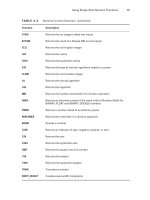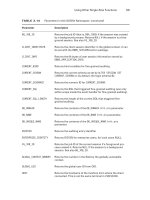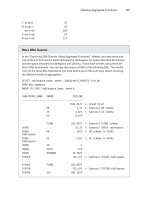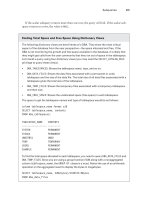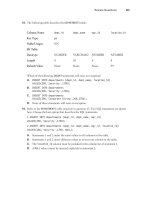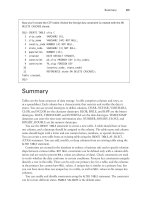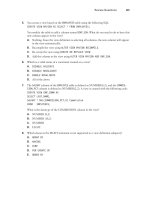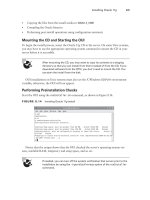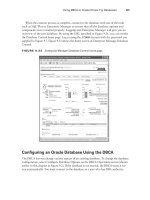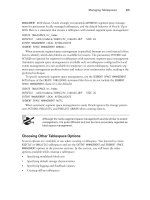Tài liệu OCA: Oracle Database 11g Administrator Certified Associate- P9 ppt
Bạn đang xem bản rút gọn của tài liệu. Xem và tải ngay bản đầy đủ của tài liệu tại đây (664.26 KB, 50 trang )
Summary
331
Now you’ll create the
CITY
table. Notice the foreign key constraint is created with the
ON
DELETE CASCADE
clause:
SQL> CREATE TABLE city (
2 city_code VARCHAR2 (6),
3 city_name VARCHAR2 (40) NOT NULL,
4 country_code NUMBER (4) NOT NULL,
5 state_code VARCHAR2 (3) NOT NULL,
6 population NUMBER (15),
7 created DATE DEFAULT SYSDATE,
8 constraint pk_city PRIMARY KEY (city_code),
9 constraint fk_cigy FOREIGN KEY
10 (country_code, state_code)
11 REFERENCES state ON DELETE CASCADE);
Table created.
SQL>
Summary
Tables are the basic structure of data storage. A table comprises columns and rows, as
in a spreadsheet. Each column has a characteristic that restricts and verifies the data it
stores. You can use several datatypes to define columns. CHAR, NCHAR, VARCHAR2,
CLOB, and NCLOB are the character datatypes. BLOB, BFILE, and RAW are the binary
datatypes. DATE, TIMESTAMP, and INTERVAL are the date datatypes. TIMESTAMP
datatypes can store the time-zone information also. NUMBER, BINARY_FLOAT, and
BINARY_DOUBLE are the numeric datatypes.
You use the
CREATE TABLE
statement to create a new table. A table should have at least
one column, and a datatype should be assigned to the column. The table name and column
name should begin with a letter and can contain letters, numbers, or special characters.
You can create a new table from an existing table using the
CREATE TABLE…AS SELECT…
(CTAS) statement. You can add, modify, or drop columns from an existing table using the
ALTER TABLE
statement.
Constraints are created in the database to enforce a business rule and to specify relation-
ships between various tables.
NOT NULL
constraints can be defined only with a column defi-
nition and are used to prevent
NULL
values (an absence of data). Check constraints are used
to verify whether the data conforms to certain conditions. Primary key constraints uniquely
identify a row in the table. There can be only one primary key for a table, and the columns
in the primary key cannot have
NULL
values. A unique key is similar to a primary key, but
you can have more than one unique key in a table, as well as
NULL
values in the unique key
columns.
You can enable and disable constraints using the
ALTER TABLE
statement. The constraint
can be in four different states.
ENABLE VALIDATE
is the default state.
95127c06.indd 331 2/18/09 6:45:51 AM
Please purchase PDF Split-Merge on www.verypdf.com to remove this watermark.
332
Chapter 6
N
Creating Tables and Constraints
Exam Essentials
Understand datatypes. Know each datatype’s limitations and accepted values. Concen-
trate on the new TIMESTAMP and INTERVAL datatypes.
Know how date arithmetic works. Know the resulting datatype of date arithmetic, espe-
cially between INTERVAL and DATE datatypes.
Know how to modify column characteristics. Understand how to change datatypes, add
and modify constraints, and make other modifications.
Understand the rules associated with changing datatype definitions of columns with rows
in a table. When the table is not empty, you can change a datatype only from CHAR to
VARCHAR2, and vice versa. Reducing the length is allowed only if the existing data fits in
the new length specified.
Understand the
DEFAULT
clause on the column definition. T h e
DEFAULT
clause provides a
value for the column if the
INSERT
statement omits a value for the column. When modify-
ing a column to have default values, the existing rows with
NULL
values in the table are not
updated with the default value.
Know the actions permitted on read-only tables Understand the various actions that are
permitted on a read-only table. Any operation that changes the data in the table is not
allowed on a read-only table. Most DDL statements are allowed, including
DROP TABLE
.
Understand constraints. Know the difference between a primary key and a unique key
constraint, and understand how to use a nonunique index for primary/unique keys.
Know how a constraint can be defined. You can use the
CREATE TABLE
or
ALTER TABLE
statement to define a constraint on the table.
95127c06.indd 332 2/18/09 6:45:52 AM
Please purchase PDF Split-Merge on www.verypdf.com to remove this watermark.
Review Questions
333
Review Questions
1. The STATE table has the following constraints (the constraint status is shown in parentheses):
Primary key
pk_state
(enabled)
Foreign key
COUNTRY
table:
fk_state
(enabled)
Check constraint
ck_cnt_code
(disabled)
Check constraint
ck_st_code
(enabled)
NOT NULL
constraint
nn_st_name
(enabled)
You execute the following SQL:
CREATE TABLE STATE_NEW AS SELECT * FROM STATE;
How many constraints will there be in the new table?
A. 0
B. 1
C. 3
D. 5
E. 2
2. Which line of code has an error?
1 CREATE TABLE FRUITS_VEGETABLES
2 (FRUIT_TYPE VARCHAR2,
3 FRUIT_NAME CHAR (20),
4 QUANTITY NUMBER);
A. 1
B. 2
C. 3
D. 4
3. Which statement successfully adds a new column, ORDER_DATE, to the table ORDERS?
A. ALTER TABLE ORDERS ADD COLUMN ORDER_DATE DATE;
B. ALTER TABLE ORDERS ADD ORDER_DATE (DATE);
C. ALTER TABLE ORDERS ADD ORDER_DATE DATE;
D. ALTER TABLE ORDERS NEW COLUMN ORDER_DATE TYPE DATE;
95127c06.indd 333 2/18/09 6:45:52 AM
Please purchase PDF Split-Merge on www.verypdf.com to remove this watermark.
334
Chapter 6
N
Creating Tables and Constraints
4. What are the special characters allowed in a table name? (Choose all that apply.)
A. &
B. #
C. @
D. $
5. Consider the following statement:
CREATE TABLE MY_TABLE (
1ST_COLUMN NUMBER,
2ND_COLUMN VARCHAR2 (20));
Which of the following best describes this statement?
A. Tables cannot be created without a defining a primary key. The table definition here is
missing the primary key.
B. The reserved word COLUMN cannot be part of the column name.
C. The column names are invalid.
D. There is no maximum length specified for the first column definition. You must always
specify a length for character and numeric columns.
E. There is no error in the statement.
6. Which dictionary view would you query to list only the tables you own?
A. ALL_TABLES
B. DBA_TABLES
C. USER_TABLES
D. USR_TABLES
7. The STATE table has six rows. You issue the following command:
ALTER TABLE STATE ADD UPDATE_DT DATE DEFAULT SYSDATE;
Which of the following is correct?
A. A new column, UPDATE_DT, is added to the STATE table, and its contents for the exist-
ing rows are NULL.
B. Since the table is not empty, you cannot add a new column.
C. The DEFAULT value cannot be provided if the table has rows.
D. A new column, UPDATE_DT, is added to STATE and is populated with the current system
date and time.
95127c06.indd 334 2/18/09 6:45:52 AM
Please purchase PDF Split-Merge on www.verypdf.com to remove this watermark.
Review Questions
335
8. The HIRING table has the following data:
EMPNO HIREDATE
--------- ----------
1021 12-DEC-00
3400 24-JAN-01
2398 30-JUN-01
What will be result of the following query?
SELECT hiredate+1 FROM hiring WHERE empno = 3400;
A. 4-FEB-01
B. 25-JAN-01
C. N-02
D. None of the above
9. What is the default length of a CHAR datatype column if no length is specified in the table
definition?
A. 256
B. 1,000
C. 64
D. 1
E. You must always specify a length for CHAR columns.
10. Which statement will remove the column UPDATE_DT from the table STATE?
A. ALTER TABLE STATE DROP COLUMN UPDATE_DT;
B. ALTER TABLE STATE REMOVE COLUMN UPDATE_DT;
C. DROP COLUMN UPDATE_DT FROM STATE;
D. ALTER TABLE STATE SET UNUSED COLUMN UPDATE_DT;
E. You cannot drop a column from the table.
11. Which actions are allowed on a table that is marked as read-only? (Choose all that apply.)
A. Truncating a table
B. Inserting new data
C. Dropping a constraint
D. Dropping an index
E. Dropping a table
95127c06.indd 335 2/18/09 6:45:52 AM
Please purchase PDF Split-Merge on www.verypdf.com to remove this watermark.
336
Chapter 6
N
Creating Tables and Constraints
12. Which of the following statements will create a primary key for the CITY table with the col-
umns STATE_CD and CITY_CD?
A. CREATE PRIMARY KEY ON CITY (STATE_CD, CITY_CD);
B. CREATE CONSTRAINT PK_CITY PRIMARY KEY ON CITY (STATE_CD, CITY_CD);
C. ALTER TABLE CITY ADD CONSTRAINT PK_CITY PRIMARY KEY (STATE_CD, CITY_CD);
D. ALTER TABLE CITY ADD PRIMARY KEY (STATE_CD, CITY_CD);
E.
ALTER TABLE CITY ADD PRIMARY KEY CONSTRAINT PK_CITY ON (STATE_CD, CITY_CD);
13. Which of the following check constraints will raise an error? (Choose all that apply.)
A. CONSTRAINT ck_gender CHECK (gender IN (‘M’, ‘F’))
B. CONSTRAINT ck_old_order CHECK (order_date > (SYSDATE - 30))
C. CONSTRAINT ck_vendor CHECK (vendor_id IN (SELECT vendor_id FROM vendors))
D. CONSTRAINT ck_profit CHECK (gross_amt > net_amt)
14. Consider the datatypes DATE, TIMESTAMP (TS), TIMESTAMP WITH LOCAL TIME
ZONE (TSLTZ), INTERVAL YEAR TO MONTH (IY2M), and INTERVAL DAY TO
SECOND (ID2S). Which operations are not allowed by Oracle Database 11g? (Choose all
that apply.)
A. DATE+DATE
B. TSLTZ–DAT E
C. TSLTZ+IY2M
D. TS*5
E. ID2S/2
F. IY2M+IY2M
G. ID2S+IY2M
H. DATE–IY2M
15. A constraint is created with the DEFERRABLE INITIALLY IMMEDIATE clause. What does this
mean?
A. Constraint checking is done only at commit time.
B. Constraint checking is done after each SQL statement is executed, but you can change
this behavior by specifying SET CONSTRAINTS ALL DEFERRED.
C. Existing rows in the table are immediately checked for constraint violation.
D. The constraint is immediately checked in a DML operation, but subsequent constraint
verification is done at commit time.
16. What is the default precision for fractional seconds in a TIMESTAMP datatype column?
A. 0
B. 2
C. 6
D. 9
95127c06.indd 336 2/18/09 6:45:52 AM
Please purchase PDF Split-Merge on www.verypdf.com to remove this watermark.
Review Questions
337
17. Which datatype shows the time-zone information along with the date value?
A. TIMESTAMP
B. TIMESTAMP WITH LOCAL TIME ZONE
C. TIMESTAMP WITH TIME ZONE
D. DATE
E. Both options B and C
18. You have a large job that will load many thousands of rows into your ORDERS table. To
speed up the loading process, you want to temporarily stop enforcing the foreign key con-
straint FK_ORDERS. Which of the following statements will satisfy your requirement?
A. ALTER CONSTRAINT FK_ORDERS DISABLE;
B. ALTER TABLE ORDERS DISABLE FOREIGN KEY FK_ORDERS;
C. ALTER TABLE ORDERS DISABLE CONSTRAINT FK_ORDERS;
D. ALTER TABLE ORDERS DISABLE ALL CONSTRAINTS;
19. You are connected to the database as user JOHN. You need to rename a table named
NORDERS to NEW_ORDERS, owned by SMITH. Consider the following two statements:
1.
RENAME SMITH.NORDERS TO NEW_ORDERS;
2.
ALTER TABLE SMITH.NORDERS RENAME TO NEW_ORDERS;
Which of the following is correct?
A. Statement 1 will work; statement 2 will not.
B. Statements 1 and 2 will work.
C. Statement 1 will not work; statement 2 will work.
D. Statements 1 and 2 will not work.
20. Tom executed the following SQL statement.
create table xx (n number, x long, y clob);
Choose the best option.
A. A table named xx will be created.
B. Single-character column names are not allowed in table definitions.
C. When using the LONG datatype, other LOB datatypes cannot be used in table
definitions.
D. One of the datatypes used in the column definition needs the size specified.
95127c06.indd 337 2/18/09 6:45:52 AM
Please purchase PDF Split-Merge on www.verypdf.com to remove this watermark.
338
Chapter 6
N
Creating Tables and Constraints
Answers to Review Questions
1. B. When you create a table using CTAS (CREATE TABLE AS SELECT), only the NOT NULL
constraints are copied.
2. B. A VARCHAR2 datatype should always specify the maximum length of the column.
3. C. The correct statement is C. When adding only one column, the column definition doesn’t
need to be enclosed in parentheses.
4. B, D. Only three special characters ($, _, and #) are allowed in table names along with let-
ters and numbers.
5. C. All identifiers (column names, table names, and so on) must begin with an alphabetic
character. An identifier can contain alphabetic characters, numbers, and the special charac-
ters $, #, and _.
6. C. The USER_TABLES view provides information on the tables owned by the user who
has logged on that session. DBA_TABLES will have all the tables in the database, and ALL_
TABLES will have the tables owned by you as well as the tables to which you have access.
USR_TABLES is not a valid dictionary view.
7. D. When a default value is specified in the new column added, the column values for the
existing rows are populated with the default value. If you include the NOT NULL constraint
with the DEFAULT value, only the dictionary is updated.
8. B. In date arithmetic, adding 1 is equivalent to adding 24 hours. To add 6 hours to a date
value with time, add 0.25.
9. D. If you do not specify a length for a CHAR datatype column, the default length of 1 is
assumed.
10. A. You can use the DROP COLUMN clause with the ALTER TABLE statement to drop a column.
There is no separate DROP COLUMN statement or a REMOVE clause in the ALTER TABLE state-
ment. The SET UNUSED clause is used to mark the column as unused. This column can be
dropped later using the DROP UNUSED COLUMNS clause.
11. C, D, E. All actions that do not modify the data in the table are permitted on a read-only
table. The actions of creating/dropping a constraint, creating/dropping an index, and drop-
ping a table are allowed. Though truncating is a DDL action, it is not permitted since the
data in the table is affected.
12. C, D. The ALTER TABLE statement is used to create and remove constraints. CREATE PRI-
MARY KEY and CREATE CONSTRAINT are invalid statements. A constraint is always added to
an existing table using the ALTER TABLE statement.
13. B, C. Check constraints cannot reference the SYSDATE function or other tables.
95127c06.indd 338 2/18/09 6:45:52 AM
Please purchase PDF Split-Merge on www.verypdf.com to remove this watermark.
Answers to Review Questions
339
14. A, D, G. You cannot add two DATE datatypes, but you can subtract to find the difference
in days. Multiplication and division operators are permitted only on INTERVAL datatypes.
When adding or subtracting INTERVAL datatypes, both INTERVAL datatypes should be
of the same category.
15. B. DEFERRABLE specifies that the constraint can be deferred using the SET CONSTRAINTS
command. INITIALLY IMMEDIATE specifies that the constraint’s default behavior is to vali-
date the constraint for each SQL statement executed.
16. C. The default precision is 6 digits. The precision can range from 0 to 9.
17. C. Only TIMESTAMP WITH TIME ZONE stores the time-zone information as a dis-
placement from UTC. TIMESTAMP WITH LOCAL TIME ZONE adjusts the time to the
database’s time zone before storing it.
18. C. You can disable a constraint by specifying its constraint name. You may enable the
constraint after the load and avoid the constraint checking while enabling using the ALTER
TABLE ORDERS MODIFY CONSTRAINT FK_ORDERS ENABLE NOVALIDATE; command.
19. C. RENAME can be used to rename objects owned by the user. ALTER TABLE should be used
to rename tables owned by another user. To do so, you must have the ALTER privilege on the
table or the ALTER ANY TABLE privilege.
20. A. The table will be created without error. A table cannot have more than one LONG column,
but LONG and multiple LOB columns can exist together. If a LONG or LONG RAW
column is defined, another LONG or LONG RAW column cannot be used.
95127c06.indd 339 2/18/09 6:45:52 AM
Please purchase PDF Split-Merge on www.verypdf.com to remove this watermark.
95127c06.indd 340 2/18/09 6:45:52 AM
Please purchase PDF Split-Merge on www.verypdf.com to remove this watermark.
Chapter
7
Creating Schema
Objects
ORACLE DATABASE 11g: SQL
FUNDAMENTALS I EXAM OBJECTIVES
COVERED IN THIS CHAPTER:
Creating Other Schema Objects
Create simple and complex views
Retrieve data from views
Create, maintain, and use sequences
Create and maintain indexes
Create private and public synonyms
95127c07.indd 341 2/17/09 12:33:19 PM
Please purchase PDF Split-Merge on www.verypdf.com to remove this watermark.
An Oracle database can contain far more objects than simply
tables. Chapter 6, “Creating Tables and Constraints,” gave
you an overview of all the major objects that can be in an
Oracle schema. In this chapter, you will learn in detail some of the schema objects, concen-
trating of course on the OCP certification exam objectives. You will be learning about cre-
ating and managing four types of schema objects in this chapter: views, sequences, indexes,
and synonyms. These four types of objects with tables are the most commonly used schema
objects in an Oracle Database.
A view is a logical representation of data from one or more tables or views. You can think
of a view as a query stored in the database. You can consider it a logical table, with rows and
columns. Oracle 11g allows you to create constraints on the views and restrict the operations
on views. In this chapter, I will discuss the uses of views, how they are created and managed,
and how to retrieve data from views.
You can use a sequence to generate artificial keys or serial numbers. Synonyms provide
aliases for objects. Indexes provide an access path to the table data. Several types of indexes
can be deployed to enhance the performance of queries. Views, sequences, synonyms, and
indexes are basic database objects that you’ll need to understand for the certification exam,
as well as for your database administration work.
Creating and Modifying Views
A view is a customized representation of data from one or more tables and/or views. The
tables that the view is referencing are known as base tables. A view can be considered as a
stored query or a virtual table. Only the query is stored in the Oracle data dictionary; the
actual data is not copied anywhere. This means that creating views does not take any stor-
age space other than the space in the dictionary.
Use the
CREATE VIEW
statement to create a view. The query that defines the view can
refer to one or more tables, to materialized views, or to other views. Let’s begin by creating
a simple view. This example will use the
EMPLOYEES
table of the
HR
schema as the base table:
SQL> DESCRIBE employees
Name Null? Type
-------------------------- -------- -------------
EMPLOYEE_ID NOT NULL NUMBER(6)
FIRST_NAME VARCHAR2(20)
95127c07.indd 342 2/17/09 12:33:19 PM
Please purchase PDF Split-Merge on www.verypdf.com to remove this watermark.
Creating and Modifying Views
343
LAST_NAME NOT NULL VARCHAR2(25)
EMAIL NOT NULL VARCHAR2(25)
PHONE_NUMBER VARCHAR2(20)
HIRE_DATE NOT NULL DATE
JOB_ID NOT NULL VARCHAR2(10)
SALARY NUMBER(8,2)
COMMISSION_PCT NUMBER(2,2)
MANAGER_ID NUMBER(6)
DEPARTMENT_ID NUMBER(4)
The following code creates a view named
ADMIN_EMPLOYEES
, with the employee informa-
tion for employees who belong to the administration department (department 10). Notice
that the
LAST_NAME
and
FIRST_NAME
columns are combined to display just a
NAME
column.
You can rename columns by using alias names in the view definition. The datatype of the
view’s columns is derived by Oracle.
CREATE VIEW admin_employees AS
SELECT first_name || last_name NAME,
email, job_id POSITION
FROM employees
WHERE department_id = 10;
View created.
SQL> DESCRIBE admin_employees
Name Null? Type
-------------------------- -------- -------------
NAME VARCHAR2(45)
EMAIL NOT NULL VARCHAR2(25)
POSITION NOT NULL VARCHAR2(10)
SQL>
If you qualify the view name with a schema name, the view will be created in that
schema. You must have the
CREATE ANY VIEW
privilege to create a view in someone else’s
schema.
The views that actually copy data from base tables and take up storage are
called materialized views. Materialized views are commonly used in data-
warehouse environments. In earlier versions of Oracle, materialized views
were called snapshots, and they are sometimes still called snapshots.
95127c07.indd 343 2/17/09 12:33:19 PM
Please purchase PDF Split-Merge on www.verypdf.com to remove this watermark.
344
Chapter 7
Creating Schema Objects
When numeric operations are performed using numeric datatypes in the view definition,
the resulting column will be a floating datatype, which is NUMBER without any precision
or scale. The following example uses
SALARY
(defined
NUMBER (8,2)
) and
COMMISSION_PCT
(defined
NUMBER (2,2)
) in an arithmetic operation. The resulting column value is the
NUMBER datatype.
CREATE VIEW emp_sal_comm AS
SELECT employee_id, salary,
salary * NVL(commission_pct,0) commission
FROM employees;
View created.
SQL> DESCRIBE emp_sal_comm
Name Null? Type
---------------------- -------- ----------
EMPLOYEE_ID NOT NULL NUMBER(6)
SALARY NUMBER(8,2)
COMMISSION NUMBER
SQL>
The maximum number of columns that can be defined in a view is 1,000,
just as for a table.
Using Defined Column Names
You can also specify the column names immediately following the view name to have dif-
ferent column names in the view. Let’s create another view using defined column names.
This view joins the
DEPARTMENTS
table to the
EMPLOYEES
table, uses a function on the
HIRE_
DATE
column, and also derives a new column named
COMMISSION_AMT
. Notice the
ORDER BY
clause in the view definition. The derived column
COMMISSION_AMT
is the NUMBER data-
type, so there is no maximum length.
CREATE VIEW emp_hire
(employee_id, employee_name, department_name,
hire_date, commission_amt)
AS SELECT employee_id, first_name || ‘ ‘ || last_name,
department_name, TO_CHAR(hire_date,’DD-MM-YYYY’),
salary * NVL(commission_pct, .5)
95127c07.indd 344 2/17/09 12:33:19 PM
Please purchase PDF Split-Merge on www.verypdf.com to remove this watermark.
Creating and Modifying Views
345
FROM employees JOIN departments USING (department_id)
ORDER BY first_name || ‘ ‘ || last_name;
View created.
SQL> DESC emp_hire
Name Null? Type
-------------------------- -------- ------------
EMPLOYEE_ID NOT NULL NUMBER(6)
EMPLOYEE_NAME VARCHAR2(46)
DEPARTMENT_NAME NOT NULL VARCHAR2(30)
HIRE_DATE VARCHAR2(10)
COMMISSION_AMT NUMBER
SQL>
If you use an asterisk (
*
) to select all columns from a table in the query to
create a view and you later modify the table to add columns, you should
re-create the view to reflect the new columns. When
*
is used, Oracle
expands it to the column list and stores the definition in the database.
Creating Views with Errors
If the
CREATE VIEW
statement generates an error, the view will not be created. You can cre-
ate views with errors using the
FORCE
option (
NO FORCE
is the default). Normally, if the base
tables do not exist, the view will not be created. If, however, you need to create the view
with errors, you can do so. The view will be
INVALID
. Later, you can fix the error, such
as creating the underlying table, and then the view can be recompiled. Oracle recompiles
invalid views automatically when the view is accessed.
As an example, suppose you try to create a new view named
TEST_VIEW
on a nonexistent
base table named
TEST_TABLE
:
CREATE VIEW test_view AS
SELECT c1, c2 FROM test_table;
SELECT c1, c2 FROM test_table
*
ERROR at line 2:
ORA-00942: table or view does not exist
95127c07.indd 345 2/17/09 12:33:19 PM
Please purchase PDF Split-Merge on www.verypdf.com to remove this watermark.
346
Chapter 7
Creating Schema Objects
Since you did not use the
FORCE
option, the view was not created. When you use the
FORCE
option, Oracle creates the view. However, trying to access the view gives an error, because
the table
TEST_TABLE
does not exist yet:
CREATE FORCE VIEW test_view AS
SELECT c1, c2 FROM test_table;
Warning: View created with compilation errors.
SELECT * FROM test_view;
SELECT * FROM test_view
*
ERROR at line 1:
ORA-04063: view “HR.TEST_VIEW” has errors
Now, let’s create the
TEST_TABLE
and access the view:
CREATE TABLE test_table (
c1 NUMBER (10),
c2 VARCHAR2 (20));
Table created.
SQL> SELECT * FROM test_view;
no rows selected
SQL>
This time, it works!
The subquery that defines the view cannot contain the
FOR UPDATE
clause,
and the columns should not reference the
CURRVAL
or
NEXTVAL
pseudo-
column. These pseudocolumns are discussed later in the chapter in the
“Creating and Managing Sequences” section.
Creating Read-Only Views
You can create a view as read-only using the
WITH READ ONLY
option. Such views can be
used only in queries; no DML operations can be performed on such views. Let’s create a
read-only view:
95127c07.indd 346 2/17/09 12:33:19 PM
Please purchase PDF Split-Merge on www.verypdf.com to remove this watermark.
Creating and Modifying Views
347
CREATE VIEW all_locations
AS SELECT country_id, country_name, location_id, city
FROM locations NATURAL JOIN countries
WITH READ ONLY;
View created.
Creating Constraints on Views
Oracle 11g allows you to create constraints on views. Constraints on views are not
enforced—they are declarative constraints. To enforce constraints, you must define them on
the base tables. When creating constraints on views, you must always include the
DISABLE
NOVALIDATE
clause. You can define primary key, unique key, and foreign key constraints on
views. The syntax for creating constraints on views is the same as for creating constraints
on a table (see Chapter 6).
The following example creates a view with constraints. Line 2 defines a column-level
foreign key constraint, line 5 defines a column-level unique constraint, and line 7 defines a
view-level foreign key constraint. The column-level constraint is called an inline constraint,
and the view-level constraint is called an out-of-line constraint.
SQL> CREATE VIEW emp_details
2 (employee_no CONSTRAINT fk_employee_no
3 REFERENCES employees DISABLE NOVALIDATE,
4 manager_no,
5 phone_number CONSTRAINT uq_email unique
6 DISABLE NOVALIDATE,
7 CONSTRAINT fk_manager_no FOREIGN KEY (manager_no)
8 REFERENCES employees DISABLE NOVALIDATE)
9 AS SELECT employee_id, manager_id, phone_number
10 FROM employees
11 WHERE department_id = 40
SQL> /
View created.
SQL>
Modifying Views
To change the definition of the view, use the
CREATE VIEW
statement with the
OR REPLACE
option. The
ALTER VIEW
statement can be used to compile an invalid view or to add and
drop constraints. Sometimes views become invalid when their underlying objects change.
95127c07.indd 347 2/17/09 12:33:19 PM
Please purchase PDF Split-Merge on www.verypdf.com to remove this watermark.
348
Chapter 7
Creating Schema Objects
Changing a View’s Definition
When using the
OR REPLACE
option, if the view exists it will be replaced with the new defi-
nition; otherwise, a new view will be created. When you use the
CREATE OR REPLACE
option
instead of dropping and re-creating the view, the privileges granted on the view are pre-
served. The dependent stored programs and views become invalid if the column list in the
old view definition differs from the new view definition and the dependent object is using
the changed/dropped column.
In the
ADMIN_EMPLOYEES
view defined earlier, you didn’t include a space between the first
name and last name of the employee. Let’s fix that now using the
OR REPLACE
option:
CREATE OR REPLACE VIEW admin_employees AS
SELECT first_name ||’ ‘|| last_name NAME,
email, job_id
FROM employees
WHERE department_id = 10;
View created.
Recompiling a View
Views become invalid when the base tables are altered. Oracle automatically recompiles the
view when it is accessed, but you can explicitly recompile the view using the
ALTER VIEW
statement. When the view is recompiled, the objects dependent on the view become invalid.
Let’s change the length of a column in the
TEST_TABLE
table created earlier. The
TEST_
VIEW
view is dependent on this table. You can see the status of the database objects in the
USER_OBJECTS
view. The following example queries the status of the view, modifies the table,
queries the status of the view, compiles the view, and again queries the status of the view:
SQL> SELECT last_ddl_time, status FROM user_objects
2 WHERE object_name = ‘TEST_VIEW’;
LAST_DDL_TIME STATUS
----------------------- -------
25-OCT-2001 11:17:24 AM VALID
SQL> ALTER TABLE test_table MODIFY c2 VARCHAR2 (8);
Table altered.
SQL> SELECT last_ddl_time, status FROM user_objects
2 WHERE object_name = ‘TEST_VIEW’;
95127c07.indd 348 2/17/09 12:33:19 PM
Please purchase PDF Split-Merge on www.verypdf.com to remove this watermark.
Creating and Modifying Views
349
LAST_DDL_TIME STATUS
----------------------- -------
25-OCT-2001 11:17:24 AM INVALID
SQL> ALTER VIEW test_view compile;
View altered.
SQL> SELECT last_ddl_time, status FROM user_objects
2 WHERE object_name = ‘TEST_VIEW’;
LAST_DDL_TIME STATUS
----------------------- -------
25-OCT-2001 05:47:46 PM VALID
SQL>
The syntax for adding or dropping constraints on a view is similar to that for modifying
the constraints on a table, but you use the
ALTER VIEW
statement instead of the
ALTER TABLE
statement. The following example adds a primary key constraint on the
TEST_VIEW
view:
ALTER VIEW hr.test_view
ADD CONSTRAINT pk_test_view
PRIMARY KEY (C1) DISABLE NOVALIDATE;
View altered.
The next example drops the constraint you just added:
ALTER VIEW test_view DROP CONSTRAINT pk_test_view;
View altered.
Dropping a View
To drop a view, use the
DROP VIEW
statement. The view definition is dropped from the dic-
tionary, and the privileges and grants on the view are also dropped. Other views and stored
programs that refer to the dropped view become invalid.
SQL> DROP VIEW test_view;
View dropped.
SQL>
95127c07.indd 349 2/17/09 12:33:19 PM
Please purchase PDF Split-Merge on www.verypdf.com to remove this watermark.
350
Chapter 7
Creating Schema Objects
Once a view is dropped, there is no rollback, and the view is not available in the Recycle
Bin. So, be sure before dropping the view.
Using Views
You can use a view in most places where a table is used, such as in queries and in DML
operations. If certain conditions are met, most single-table views and many join views
can be used to insert, update, and delete data from the base table. All operations on views
affect the data in the base tables; therefore, they should satisfy any integrity constraints
defined on the base tables.
The following are some common uses of views:
To represent a subset of data For security reasons, you may not want certain users to see
all the rows of your table. You may create a view on the columns that the users need to
access with a
WHERE
clause to limit the rows and then grant privileges on the view.
To represent a superset of data You can use views to represent information from multiple
normalized tables in one unnormalized view.
To hide complex joins Since views are stored queries, you can have complex queries
defined as views, where the end user doesn’t need to worry about the relationship between
tables or know SQL.
To provide more meaningful names for columns If your tables are defined with short and
cryptic column names, you may create a view and provide more meaningful column names
that the users will understand better.
To minimize application and data-source changes You may develop an application refer-
ring to views, and if the data source changes or the data is derived in a different manner,
only the view needs to be changed.
Using Views in Queries
You can use views in queries and subqueries. You can use all SQL functions and all the clauses
of the
SELECT
statement when querying against a view, as you would when querying against
a table.
When you issue a query against a view, most of the time Oracle merges the query with the
query that defines the view and then executes the resulting query as if the query were issued
directly against the base tables. This helps you use the indexes, if there are any defined on
the table.
Let’s query the results of the
EMPLOYEE_DETAILS
view created earlier:
SQL> SELECT * FROM emp_details;
EMPLOYEE_NO MANAGER_NO PHONE_NUMBER
----------- ---------- --------------
203 101 515.123.7777
95127c07.indd 350 2/17/09 12:33:19 PM
Please purchase PDF Split-Merge on www.verypdf.com to remove this watermark.
